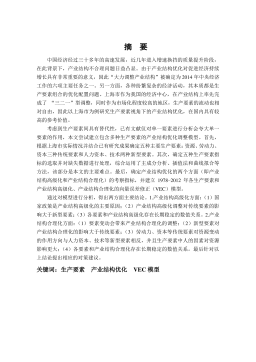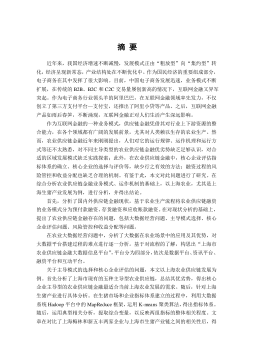分布式工作流环境中数据管理的研究
摘要工作流管理系统的概念起源于是办公自动化领域,它根据一些定义好的规则,把任务或信息在参与者之间传递。这一概念是支持业务过程高效运行的思想、理论、方法、技能和系统的总称,是企业业务过程重组以及业务过程的自动化的关键技术。在当前复杂、异构、分布的企业环境中,分布式的工作流管理系统逐渐成为研究热点。然而,人们更多的是关注分布式工作流系统的过程建模、任务的调度算法等方面,对于工作流中数据管理的研究比较少,本文把工作流系统中的数据管理作为一个主要研究内容,重点研究分布式工作流环境中数据管理的三个方面:异构数据的交互、数据一致性保护、资源数据的自适应分配。本文首先介绍了课题的研究背景和国内外研究现状,其...
相关推荐
-
我国基层财政困难的制度成因分析与对策研究VIP免费

 2024-09-20 46
2024-09-20 46 -
我国煤电产业链纵向交易合约机制研究VIP免费

 2024-09-20 44
2024-09-20 44 -
生产要素视角下的上海市产业结构优化研究VIP免费

 2025-01-09 8
2025-01-09 8 -
我国银行业结构与经济结构关系研究VIP免费

 2025-01-09 18
2025-01-09 18 -
大数据视角下农业供应链金融研究VIP免费

 2025-01-09 14
2025-01-09 14 -
跨国大型综合超市的规划研究VIP免费

 2025-01-09 9
2025-01-09 9 -
跨境电商农产品质量安全问题研究VIP免费

 2025-01-09 9
2025-01-09 9 -
世界市场的虚拟化与我国国际电子商务发展方向研究VIP免费

 2025-01-09 46
2025-01-09 46 -
中国政府对电力行业的价格规制问题研究VIP免费

 2025-01-09 20
2025-01-09 20 -
中小企业信息化系统集成技术研究VIP免费

 2025-01-09 30
2025-01-09 30
相关内容
-

跨国大型综合超市的规划研究
分类:高等教育资料
时间:2025-01-09
标签:无
格式:PDF
价格:15 积分
-

跨境电商农产品质量安全问题研究
分类:高等教育资料
时间:2025-01-09
标签:无
格式:PDF
价格:15 积分
-

世界市场的虚拟化与我国国际电子商务发展方向研究
分类:高等教育资料
时间:2025-01-09
标签:无
格式:PDF
价格:15 积分
-

中国政府对电力行业的价格规制问题研究
分类:高等教育资料
时间:2025-01-09
标签:无
格式:PDF
价格:15 积分
-

中小企业信息化系统集成技术研究
分类:高等教育资料
时间:2025-01-09
标签:无
格式:PDF
价格:15 积分






